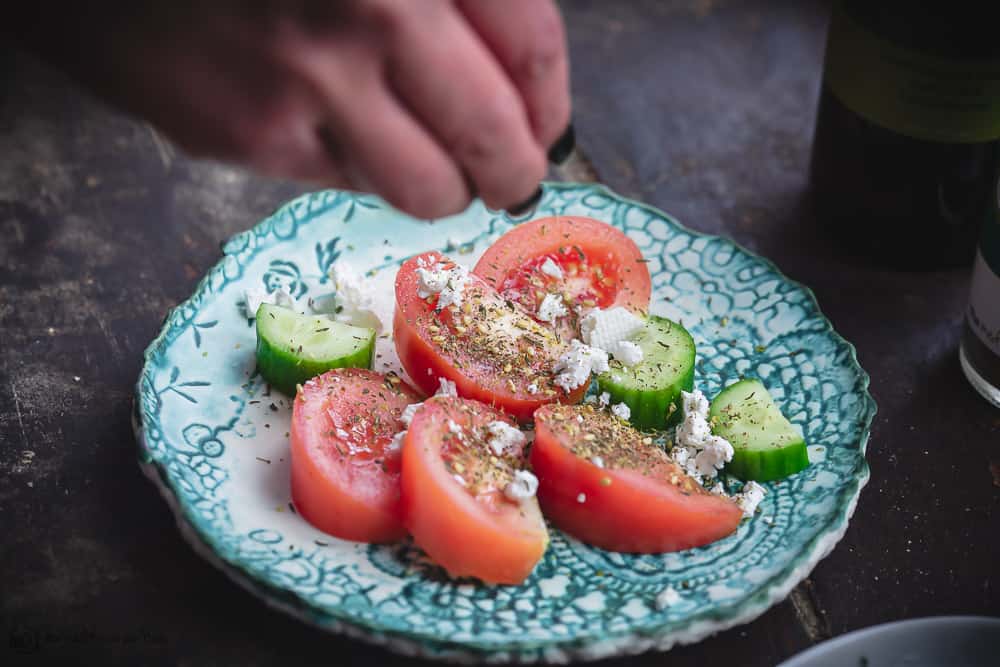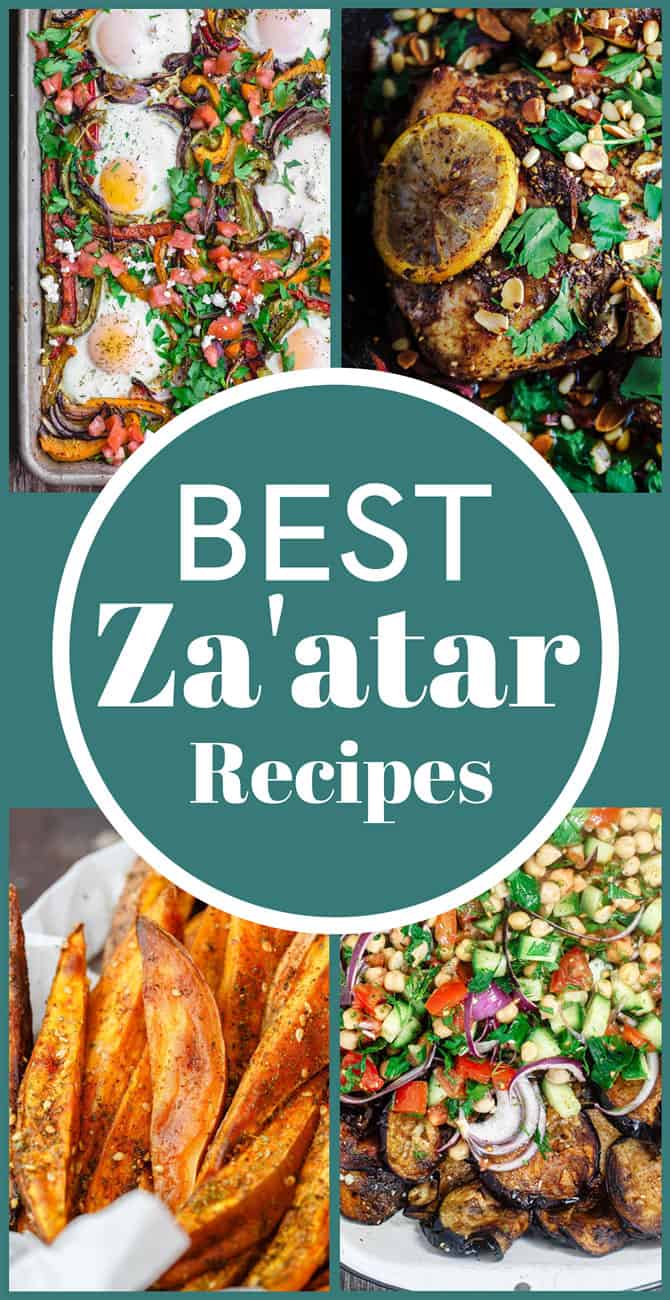If there is one seasoning blend I absolutely cannot live without, it’s za’atar! This aromatic Middle Eastern blend of herbs, sesame seeds, and sumac will transform your cooking. Not all za’atar is created equal, though. Today, let’s dig into what is za’atar (spice or herb?). What does quality za’atar consist of? And the many delicious ways to use it!
Be sure to grab my list of 11 BEST za’atar recipes below. From amazing salads to the best roast chicken, breakfast, and more!

What is za’atar (zaatar)?
I love highlighting my favorite Mediterranean pantry ingredients, like I do in my Aleppo pepper guide. Today, I’m sharing everything you need to know about one of the most-used seasonings in my spice cabinet, za’atar.
Za’atar (pronounced Zaah-tar) is most identified with Middle Eastern and Mediterranean cooking. A combination of herbs, sesame seeds, sumac, and salt, it is one of the world’s unique and best seasonings. It’s loaded with bold flavors, has great texture, and even boasts some health benefits–from soothing inflammation to boosting cognition!
Many don’t know this, but the Arabic word Za’atar (zaatar) also describes an actual herb that’s in the wild thyme family which starts its life looking more like oregano (Blends that stick to the traditional taste will include Mediterranean wild thyme in them.)

What’s in it? Not all za’atar is created equal
So, we said Zaatar is a combination of herbs, sesame seeds, and sumac (a tangy red spice from sumac berries – get more info about it in our sumac guide!). How much sumac? White or toasted sesame seeds? What else is added?
There are no official standards out there, and that’s why you’ll find different variations of zaatar seasoning on the market.
As someone who’s of Mediterranean origins and who has tried many blends over the years (more than I care to remember), I can tell you, not all za’atar is created equal. Taste, texture, and quality will vary a lot.
Sadly, many blends will not include quality herbs. To increase volume and lower prices, cheaper za’atar blends include a large amount of fillers in the form of wheat, flavored ground straw or husk. And many will substitute citric acid for sumac.

Quality all-natural za’atar seasoning and where to find it
You can find za’atar in the spice section at health food stores or Mediterranean and Middle Eastern grocery stores. My best advice to you is to look at the the label carefully and ask questions. Look for za’atar that contains quality wild thyme (or hyssop) and sumac (not citric acid.)
Make sure the ingredients are all natural and nothing else is added. Look at it carefully, it should have good texture and look more on the green side (like the picture above).
Let me tell you about the blend I use
The Mediterranean Dish za’atar is sourced from trusted suppliers, includes only quality all-natural ingredients, and stays true to traditional taste and texture. An aromatic blend with both earthy and subtle citrus undertones, and just a hint of nuttiness, it includes:
- High quality, fragrant French wild thyme, which adds robust flavor along with oregano.
- Toasted sesame seeds (as opposed to the standard white), which adds a sweet, nutty flavor
- A good amount of quality ground sumac from Mediterranean sumac berries, which adds a subtle lemony and earthy flavor; the perfect balance to the wild thyme and oregano. And a small pinch of kosher salt to round everything out.
Remember, many lower quality zaatar blends substitute citric acid for sumac and add other fillers like wheat and flavored straw to increase volume.
Where to Buy? If you live in the USA, you can find our all-natural za’atar at our online store.

How to use za’atar (zaatar): 13 BEST Za’atar Recipes
I use zaatar on a regular basis. It’s great to simply season some avocados or tomatoes for a snack (drizzle a little extra virgin olive oil), to generously season pillowy homemade bread rolls, to jazz up some breakfast eggs and spinach pasta, or to include with olive oil for dipping as part of a big Mediterranean spread.
But I also use it to season salads, meats and even fish. Here are 13 favorite recipes using za’atar:
- Grilled Eggplant Salad with Za’atar Pita Crisps
- Savory Galette with Summer Veggies and Za’atar
- Za’atar Roasted Chicken
- Chickpea Salad with Eggplants
- Olive Oil Baked Sweet Potato Fries

- Mediterranean Sheet Pan Baked Eggs & Veggies
- Za’atar Garlic Salmon and Veggies
- Manaqish (Za’atar Flatbread)

- Mediterranean Avocado Salad
- Mediterranean Sweet Potato Toast
- Mediterranean Breakfast Toast with Hummus
- Mediterranean Flat Bread with Arugula and Smoked Salmon
- Pita Breakfast Pizza with Za’atar

Head over to The Mediterranean Dish Store to grab some today!
Try our Ultimate Mediterranean Spice Bundle Or the Exotic 4 Bundle!

You may also like:
How to make dukkah (Egyptian Dukkah Recipe)

Love your presentations and the explanation of all we take for granted. Fantastic work. 🙏
Hi….I’ve been following your page for awhile now and even receive emails with the weekly menu ideas…wich I LOVE LOVE LOVE by the way. My question is, does it matter which olive oil you use (Spanish/Greek/Italian) for any given dish? Are they interchangeable or does one do better in certain recipes? TYIA
Hi, Kimberly. I typically choose the olive oil I’m going to use based on the flavor profile I’m trying to achieve. In many recipes, it really doesn’t matter too much, but sometimes, it does. Sorry I can’t give you a very straight answer here. It can often just come down to personal preference.
I heard about zaatar on some of the cooking shows so I bought some not knowing how it tasted! I must say I tried some just on my finger and it was horrible !!!!! I hope if I try it in one of your recipes it tastes good. By itself is it supposed to taste terrible?
Hi, Joyce. On its own, it might be a bit strong, but I’ve not know it to taste terrible. We use it quite often in recipes and to top veggie side dishes and dips and find it to be a wonderful addition.
How comes that French thyme is required to make an ancient Middle East spice? That’s bonkers.
From what I’ve read, Middle Eastern wild Thyme is what’s traditionally used, but since it’s hard to get outside of the Middle East, French Thyme has roughly the same flavor profile, and so is a good substitute.
I’ll be trying the chick pea salad it sound amazing I love chick peas
Thanks for sharing
Hope you enjoy it, Myrna!
Looking too use big bag zaatar in new ways I first learned of the spice working with the Lebanese client he had the pizza and when send me to the Lebanese store to buy it I mean the Mediterranean store
Hi, Kim! Hope you find some great ideas here!!
can i use zaatar as dry rub for pork ribs? I will then finish the pork ribs with bbq sauce. Do they go together?
I’ll bet it would make a great dry rub, Janet, but I’m not sure how well it will go with BBQ sauce.
Hello,
I found your site by accident, am so glad I did. Your recipes are great and you make it look so easy.
Thank for your lovely dishes, I cant wait to try the Hummus, for starters!
keep them coming.
That’s great! I hope you enjoy!
I am a new here but I love your recepies and I bought 3 spice blends, one of them is za’atar.
Viola, that’s awesome! Enjoy!!!
Wondering if you can use Za’atar on popcorn…?
I love za’atar seasoning! Can’t live without it either! These are great recipe ideas!
Thanks for the great recipes and information. I’ve tried and really like Lebanese Zaatar by “The Spice Way”.
Thanks for sharing!
This is really awesome! I haven’t used za’atar before but this is really interesting!
I can’t wait for you to give za’atar a try!
This sounds so tasty!! I can’t wait to find it & try it! I bet it adds so much flavor!
Awesome, Kristyn! BTW, if you are in the USA, you can find za’atar right here at our online shop: https://shop.themediterraneandish.com/product/zaatar-spice-blend/
Excited to try a new spice, looks amazing!
Awesome!
Thanks for the info this is great to know!
My pleasure! Enjoy!